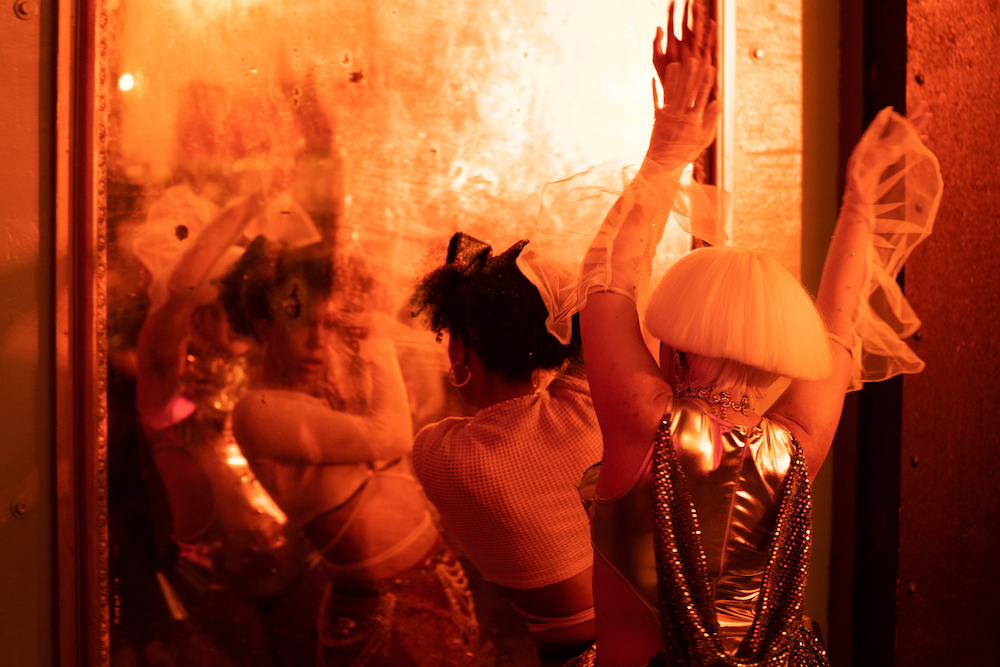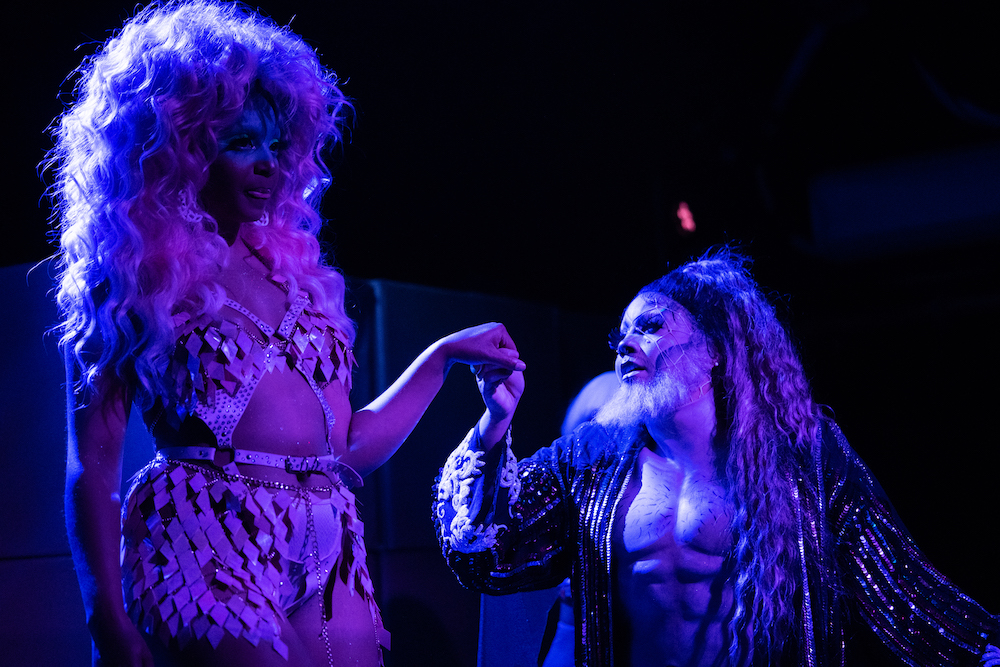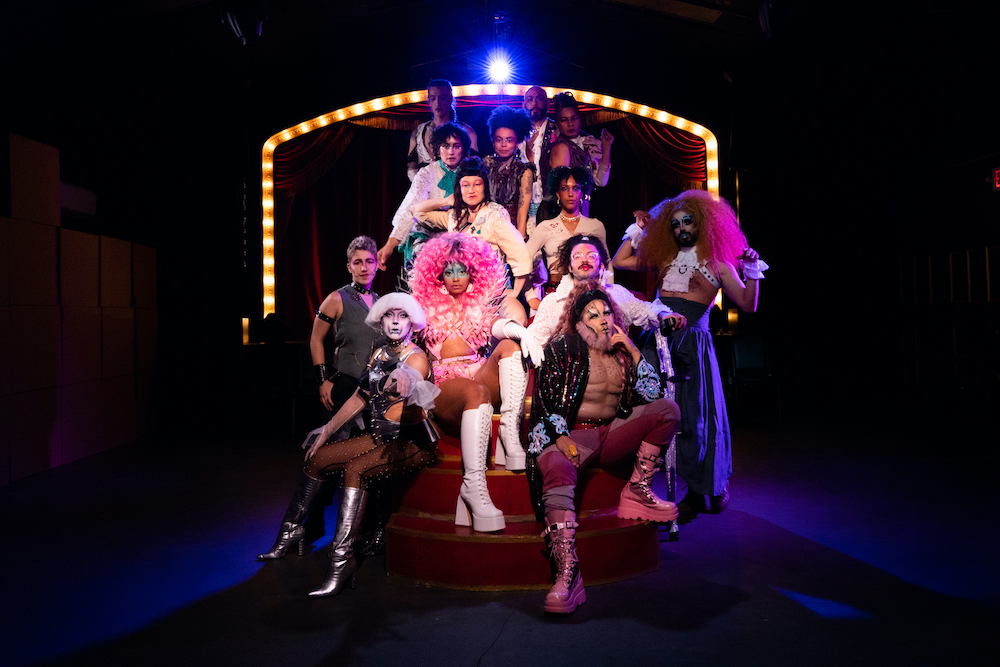It seems like a lifetime or longer since I was even in the vicinity of SF drag-haven Oasis, especially in light of recent events. When venues began welcoming back patrons in late 2021, I felt that Oasis’ safety measures were a bit lax. I finally agreed to attend a show knowing that masks would be required. The invitation came shortly after learning that the venue’s co-founder Heklina had passed away. I wound up unable to attend the opening due to catching that virus the media now ignores (despite it being responsible for 1,000 US deaths per week.) As I fought through that, Black trans man Banko Brown was killed—and Oasis co-founder D’Arcy Drollinger was named SF’s first-ever drag laureate.
So yeah, a lot’s happened since I was last in the Oasis orbit. If nothing else, I can say that the event that brought me back was a pretty entertaining one.

Offhand, I’m not familiar with the work of Detour, but I was taken by the way the group’s latest immersive dance production, We Build Houses Here (whose run has been extended to Thu/25 and Fri/26), has a feel to it that’s both timeless and timely. It starts off with that classic narrative catalyst, the shipwreck, as a jumping-off point for a collection of vignettes pondering loneliness, resourcefulness, heartbreak, and epiphany, to name but a few themes. Mercifully, there are no blood-stained volleyballs anywhere in sight.
There is, however, Enya. Indeed, her New Age classic “Orinoco Flow” is the first of many water-themed songs— including Florence + The Machine’s “Ship to Wreck,” an accordion-led version of Tim Buckley’s “Song to the Siren,” ABBA’s “SOS,” and Mr. Twin Sister’s “I Want a House”—played or covered throughout the course of the show.
Patrons are given are given colored wristbands before the show, dividing us into groups of red or blue. After a welcome by Churro Nomi—in which we’re told we’re now adrift at sea, and that “The ocean can be rude”—we’re led into the Oasis theatre by a collection of colorful sea spirits (the flamboyantly pink Cheetah Biscotti, the shimmering Glamputee, the Priss-from-Blade–Runner-meets-Tin-Man-adorned Lisa Frankenstein, and the lion-like Mudd.) It’s here that we all witness the aforementioned shipwreck, leaving its crew island-bound like something out of Shakespeare or Stevenson.

The Reds and Blues are then split up to follow the various fates of these characters. As a Blue, I was led back to the lobby-cabaret area to meet possibly-the-only-named-character, Adam (Wily Naman Strasser), and his survival companion (the always-watchable Erin Mei-Ling Stuart.) She found a book on the beach, which he considers useless amongst potential survival gear. Yet, she’s the one who built a shelter (hence the title) and has to walk him through tying a sheepshank.
He asks her if she misses her old life back on the mainland. She hesitates before replying that Adam’s (apparently non-sexual) companionship is enough for her. She then soliloquizes to us about how her heart was so broken by a lover that one day she just started walking and somehow wound up on a ship—the very ship that crashed into this island.
As I wasn’t privy to all stuff the Reds saw (paths frequently overlap as each group is guided throughout every level of Oasis, including the roof), I can’t say how much this directly figures into the overall narrative. Still, I’d happily watch Bay Area veterans Stuart and Nasser as the only two people on a deserted island, even if it weren’t punctuated by hypnotic twerking of the aforementioned sea spirits. The story of Adam and his nameless companion was intriguing enough that I wish that it alone was the narrative through-line for the show. When we again stumble upon the woman writing letters in bottles to her nameless lover or Adam stringing hankies together to count the things he’s lost (“My first love … my keys … so many fucking socks … Mission Pie … The Stud …”—yes, he name-drops shuttered SF businesses), it’s genuinely heartbreaking.
Not that the other moments lack such heft. One sequence features another ship passenger going through a box, but misidentifying the contents therein, eventually pulling out nothing and succumbing to isolation madness. However, these various threads don’t really come together at the end so much as just stop. I don’t know what I was expecting for a finale, but lead director Eric Garcia (Nomi’s non-drag persona, who co-directed with three others) and playwright Brian Thorstenson (who collaborated on the script with cast members) seem happier to acknowledge the complex emotions rather than thoroughly process them. True, not all problems can be neatly resolved, but narrative arcs exist for a reason.

Having said that, the performances of the actors and dancers are constantly hypnotic, be it an energetic Biscotti solo in the cabaret, a quiet frustration piece near the bar, or any number of sequences lip-syncing the aforementioned pop hits and wearing Abdiel Portalatín Perez’s eye-popping costumes. If the point was for the audience to focus more their experience than the story, then this production has succeeded.
Although the show requires patrons to be masked, none of the Oasis staff wore them. Also, patrons frequently had them off to drink, and an older white couple never once put masks on. Walking inside and outside meant different CO² levels, but my Aranet4 read a top indoor level of 2073ppm in the main theatre at the end of the show.
At the risk of falling back on cliché water puns: the majority of We Build Houses Here flows like a centuries-old stream, but in several moments one feels adrift, rather than sailing towards an intended destination. The performers and tech crew bring illustrious life to their work in the former home of Heklina. Maybe a bit more work on the book would make it an even grander tribute.
WE BUILD HOUSES HERE has been extended to Thu/25 and Fri/26. Oasis, SF. Tickets and more info here.





